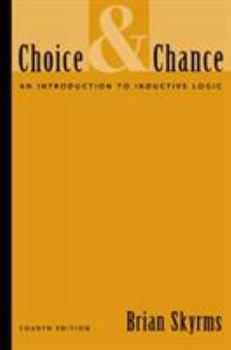Choice and Chance: An Introduction to Inductive Logic
Select Format
Select Condition 
Book Overview
* Survey of a number of issues in inductive logic that sets the stage for more advanced discussion. This description may be from another edition of this product.
Format:Paperback
Language:English
ISBN:0534557376
ISBN13:9780534557379
Release Date:November 1999
Publisher:Wadsworth Publishing
Length:184 Pages
Weight:0.62 lbs.
Dimensions:0.5" x 5.9" x 9.0"
Customer Reviews
2 ratings
Good Introduction to Inductive Logic
Published by Thriftbooks.com User , 20 years ago
This book, in its 4th edition, was one of the first textbooks oninductive logic I read. Here is the table of contents:1. Basics of Logic2. Probability and Inductive Logic3. The Traditional Problem of Induction4. The Goodman Paradox and the New Riddle of Induction5. Mill's Methods of Experimental Inquiry and the Nature of Causality6. The Probability Calculus7. Kinds of Probability8. Probability and Scientific Inductive LogicAnswers to Selected ExercisesIndexI did not read this textbook as a textbook for a class, but instead read it independently. I also did all of the exercises in the entire book, and used the answers at the end of the book to verify my answers whenever possible. Overall, I was very pleased with the textbook. The explanations were mostly clear, and the progression of topics from the simple to complex was appropriate. I have two minor complaints about the book. The first regards chapter 7, where Skyrms discusses, among other topics, the chance function as well as the von Neumann-Morgenstern theory of utility. I don't know if this is a statement about the textbook or the reader, but I felt the explanations of those two topics were less clear than other sections of the book. I was able to compensate for that by doing Internet searches on those two topics, however, so it wasn't a major inconvenience.The second complaint regards the answers to exercises. As the other reviewer noted, the back of the book is incorrect when it states there are "completely worked out solutions at the back of the book for every other problem." Off the top of my head, I would say that is probably true 80-85% of the time, with most of the exceptions occurring towards the end of the book. This is unfortunate, since the most complex exercises are naturally found towards the end of the book. In particular, the exercise for section VII.6 (on chance) on p. 150 is enormously complicated, and cries out for an answer. There should have been a second exercise for that section, so that at least one exercise would have had a fully worked out solution in the back of the book.Despite these two complaints, however, this is still an excellent book. Overall, Skyrms has provided his readers and students with a helpful introduction to inductive logic.
A Good Introduction to Induction
Published by Thriftbooks.com User , 22 years ago
This is a good introduction to logic, inductive and, to a lesser extent, deductive. It probably serves better as a textbook than as an aid to individual learning, but under the proper conditions and with the proper reader, it could serve both. I liked it best when it was explaining the truth tables and the rules of the calculus of probability. Particularly interesting are the practical applications in the exercises, especially in cards and dice and, to a lesser extent, horse racing. The concepts of utility and belief need amplification because they come off too briefly in relation to their importance. No one who has mastered this book would ever have trouble calculating the exact value of a bet - a benefit of some importance to us gamblers. I have never seen or heard of the theory of marginal value applied to money. It certainly applies to other things, like water. Too little water makes water very valuable, enough is enough, and too much gives water a negative value (as in our current flooding in Texas). Skyrms is right about some aspects of money: Too little and it hurts. Don't believe me? Try walking around New York City on the weekend with only a dime in your pocket. A poor man would be a fool to risk $1000 on an even money bet. Because if he lost, it would hurt a lot. A rich man could lose that bet and not suffer at all. And of course, enough money is good. Therefore, money does have a relative value. Whether it has a marginal value (too much is bad) is debatable. Some things that might be corrected in the next addition: The answers to the exercises should have pages numbers for more easy reference. The cover is wrong in saying there are answers for every other problem. That is only partially true and in fact some exercises have no answers eg VIII 3 has no answers to any exercise. And Symes is wrong in assuming that evaluating all the evidence doesn't cost anything (page 154). It costs time and trouble. Whether it is worth it would depend on the situation.





